May 16, 2025 | 10:17 GMT +7
May 16, 2025 | 10:17 GMT +7
Hotline: 0913.378.918
May 16, 2025 | 10:17 GMT +7
Hotline: 0913.378.918

Lobster farming area in Van Ninh district, Khanh Hoa province. Photo: KS.
According to Mr. Tran Minh Hien, an ornate rock lobster farmer in Khai Luong hamlet, Van Thanh commune, Van Ninh district, local aquaculture activities have faced significant challenges within the last two months. During the summer season, the extreme heatwaves and fluctuating water conditions have caused farmed lobsters to die en masse.
Mr. Hien's family owns a farm of over 1,000 lobsters, with each weighing between 0.6 and 0.7 kilograms; however, an average of six to seven lobsters expire on a daily basis. Mr. Hien's farm is considered a small-scale operation within the district; with larger farms suffer considerably heavier losses.
Mr. Tran Minh Hien reported that the lobsters exhibited a range of symptoms prior to their death, including blackened gills, ruptured shells, and swelling in their abdomens. Furthermore, the declining lobster market price, which fluctuates between 900 and 920 thousand Vietnamese dong per kilogram, in combination with traders' limited purchases due to the focus on domestic consumption exacerbate farmers' concerns. Consequently, local farmers are facing the risk of significant financial losses.
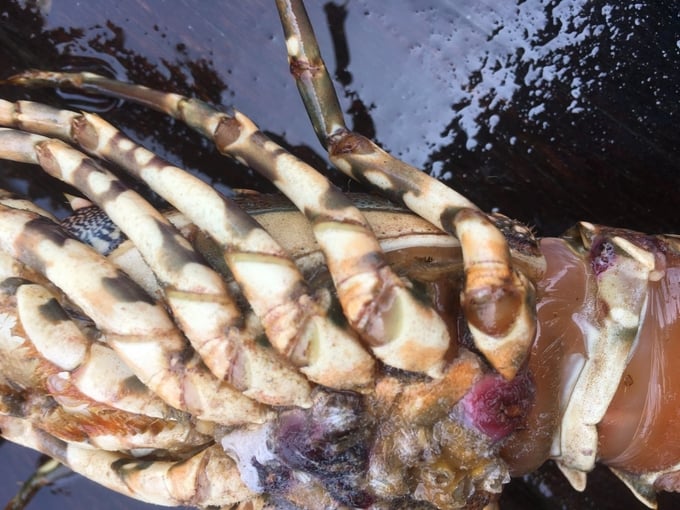
Close-up of a dead lobster. Photo: KS.
In addition to Van Thanh commune, farmers in the coastal areas of Van Hung commune, Van Ninh district have reported a high number of lobster deaths.
According to Mr. Nguyen Hue, a farmer from Xuan Vinh hamlet, Van Hung commune, his lobsters have repeatedly died en masse within the last two months. The deaths, although initially sporadic, are now occuring at a rapid rate. Reportedly, lobsters are dying to varying extents in the majority of farming cages in the hamlet.
Mr. Hue's farm has observed an increased mortality rate in lobster over the last month. His family retrieves at least 3 to 4 kilograms of dead lobsters on a daily basis, with each lobster weighing between 0.1 and 0.2 kilograms. Prior to their deaths, the lobsters exhibited a range of symptoms, including: clinging to the corners of the cage and a loss of appetite. Notably, white bellies, which is a symptom of Milky haemolymph disease, were observed on the retrieved dead lobsters.
According to Mr. Tran Trung Thong, Vice Chairman of Van Hung commune-level People's Committee, local lobster farming activities are currently experiencing the highest level of mortality rate in its history. Consequently, local governments have coordinated with relevant agencies to collect samples, identify the cause of death, and provide guidance to farmers on disease prevention.
After receiving reports of lobster deaths in the farming area of Khai Luong hamlet, Van Thanh commune, Van Ninh district, Khanh Hoa province's Sub-Department of Livestock Production and Animal Health has instructed the Van Ninh district's Livestock Production and Animal Health Station to collaborate with the Sub-Department of Fisheries to conduct inspection and gather epidemiological information.
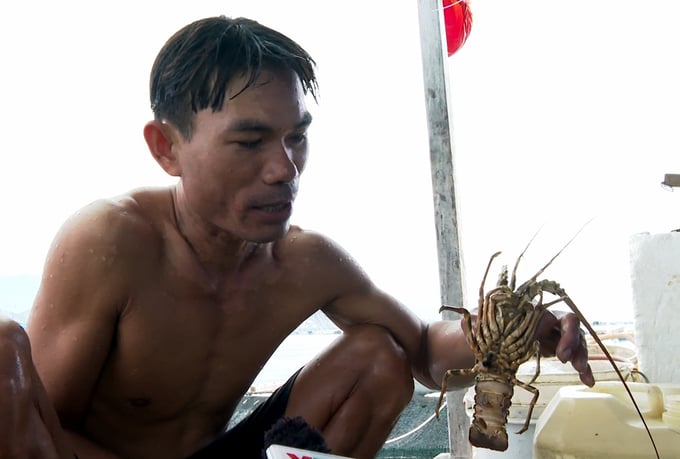
Farmers reported that there has been a recent increase in lobster deaths. Photo: KS.
Accordingly, the majority of the environmental indicators were found to be within permissible limits, with the exception of the dangerously low level of dissolved oxygen content at 3mg/L.
Khanh Hoa province's Sub-Department of Livestock Production and Animal Health also conducted tests on two lobster samples for traces of parasites and Vibrio spp. bacteria, and performed a fresh examination of the lobster samples. The samples exhibited several external symptoms, including unaffected appendages, soft and fragile shell texture, localized blackened gills, and signs of necrosis.
The fresh examination discovered traces of Vibrio sp. infection in the lobster samples but no evidence of parasites. Consequently, the cause of the mass lobster deaths remains undetermined.
On the other hand, the lobster deaths coincide with the change in seasons and the abnormal weather conditions. Moreover, the lower than permissible level of dissolved oxygen content, coupled with the lobsters' weakened immune system, also contribute to the mass deaths.
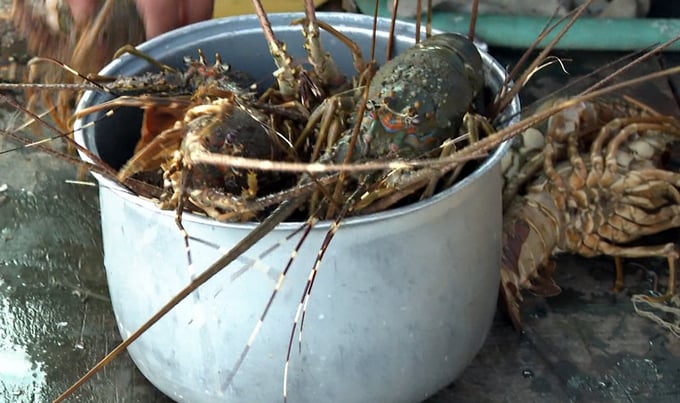
Lobster farmers in Van Hung commune retrieving dead lobsters. Photo: KS.
Khanh Hoa province's Sub-Department of Livestock Production and Animal Health issued a report on April 11 after conducting inspection and gathering epidemiological information in the lobster farming area of Ha Gia hamlet, Van Hung commune.
According to the report, environmental indicators, which were measured on April 8 in areas with lobster deaths, were all found to be within permissible limits. External examination of the lobster samples revealed no signs of tail erosion, blackened gills, or white spots on the lobster's abdomen.
The Sub-Department conducted further testing on two samples to detect traces of parasites and Vibrio spp. bacteria. Additionally, the Sub-Department sent three samples for specialized testing to identify the causative agent of Milky haemolymph disease in lobsters.
The test discovered traces of Vibrio sp. infection, but no evidence of parasites or the Rickettsia bacterium, which causes Milky haemolymph disease in lobsters. Consequently, the cause of the mass lobster deaths remains undetermined.
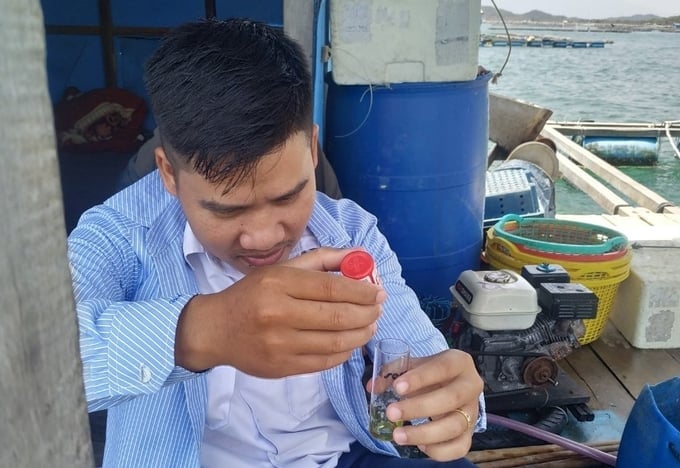
Local officials collecting samples from diseased lobsters. Photo: KS.
In response to this issue, Khanh Hoa province's Sub-Department of Livestock Production and Animal Health advises aquaculture farmers to regularly monitor and measure environmental indicators, with a focus on oxygen levels during seasonal transitions to take immediate response actions. The Sub-Department also recommends farmers to monitor weather fluctuations and changes in the color of the water in farming areas, and promptly implement corrective measures.
Additionally, farmers should closely monitor the health of their lobster populations, as well as remove dead lobsters, shed exoskeletons, and excess feed on a daily basis to limit the accumulation of organic matter in the water and sediment.
Farmers should add vitamins and minerals to feed to enhance the lobsters' immune system; adjust feed rations based on weather fluctuations and the health of the lobsters; avoid excess feed that can lead to waste buildup and create a favorable environment for disease-causing microorganisms.
On the other hand, Van Ninh district's Livestock Production and Animal Health Station was instructed to continue monitoring of the spread of the disease in Khai Luong hamlet, Ha Gia hamlet, and neighboring farming areas within Van Hung commune. The Sub-Department also emphasized the importance of maintaining regular communication with farmers regarding the health of the farmed lobster populations.
On April 10, Khanh Hoa province's Department of Agriculture and Rural Development issued a request for Van Ninh district and the Research Institute for Aquaculture III to establish a survey team to assess the cause of death, and report to the provincial People's Committee.
Translated by Nguyen Hai Long

(VAN) Cold-barn systems efficiently manage environmental and temperature conditions, which aids in the prevention of respiratory diseases in pigs and protects them from the vectors that transmit African swine fevers.
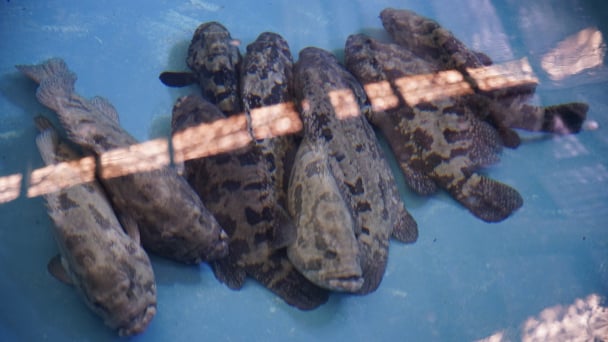
(VAN) To tackle challenges, the project 'Addressing key technical bottlenecks in the grouper supply chain in Vietnam' has been underway since 2024.
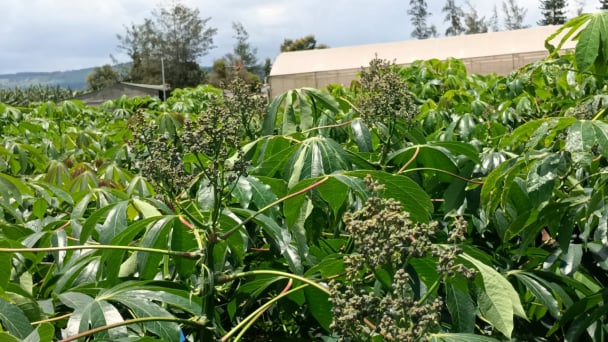
(VAN) The project 'Disease-Resilient and Sustainable Cassava Production Systems in the Mekong Region', funded by the Australian Center for International Agricultural Research (ACIAR), is being implemented from 2024 to 2028.

(VAN) Data from 10,000 farming households will help professionalize production organization and support the implementation of the One Million Hectares Program for High-Quality, Low-Emission Rice Cultivation.

(VAN) FAO Director-General QU Dongyu marks International Day of Plant Health at NENA conference.

(VAN) Deputy Minister of Agriculture and Environment Hoang Trung affirmed that floriculture and ornamental plants are a growing industry that receives significant global attention.

(VAN) The three staple crops dominating modern diets – corn, rice and wheat – are familiar to Americans. However, fourth place is held by a dark horse: cassava.